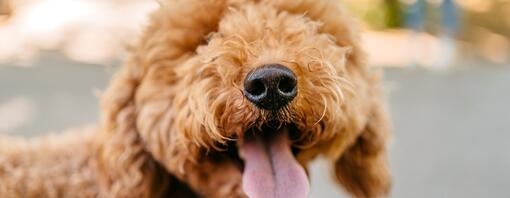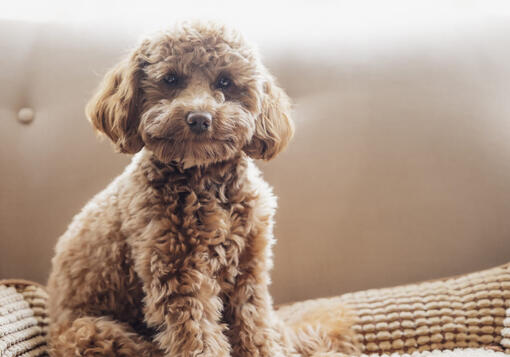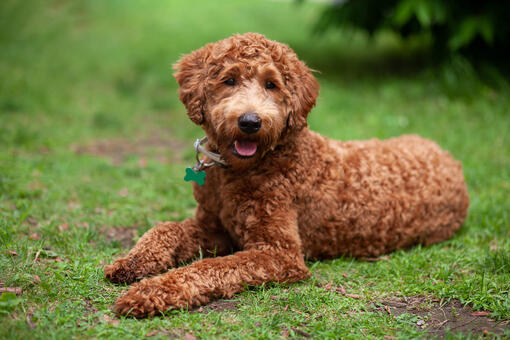
The 2020’s could be reasonably described as the Doodle Era – with designer crossbreeds, and poodle crossbreeds in particular, having never been so popular.
Many of these breeds have the reputation of being perfect family dogs. After all, they are just the right size for a family home, non-shedding, great temperaments, loads of fun, and easy going. And some certainly are but…
Despite this increase in popularity of these adorable, often comedically named, curly-haired dogs (and a whole host of other crossbreeds, all with their own invented names to make them sound like a real breed) there’s a wealth of myth and urban legend surrounding them and their suitability as a companion dog - and much of it stems from a basic lack of understanding of canine genetics.
Read on to find out all you need to know about cross breeding dogs, including what a crossbreed dog is and what a purebred dog is!
What is a purebred dog?
Purebred dogs have to have parents and grandparents of the same breed and their ancestry can usually be traced without any difficulty. Breed associations usually require them to be at least 87.5% of the given breed to be considered purebred.
What is a crossbreed dog?
A crossbreed dog has parents of different and distinct breeds. This can be a mix of two or more but the breeds are usually known with cross breed dogs. This differs to mixed-breed dogs, whereby the mixes of breeds are unknown/undocumented.
Pure breed vs a crossbreed dog – what are the differences?
As we mentioned above, a purebred dog is a single breed whose lineage can be traced to find parents and grandparents of the same breed. A crossbreed is where the parents are of different breeds, but these breeds are known and/or documented.
Before we tell you the misconceptions about crossbreed dogs, it’s important to know what to expect from a pure breed dog or a crossbreed. We’ve noted the differences between the two below.
Pure breed dogs – what can we expect?
The advantage of buying a pure breed dog is that you know what you are going to get. One of the things that The Kennel Club look for when they accept breeds for registration is that they breed “true to type”. This means that you know:
- What they are going to look like
- What size they are
- How much exercise they are going to need
- How much grooming they need
- How much coat they will shed
- How noisy they are
- Pretty much what their personalities are going to be like (with variations… because all dogs are individuals)
So, ‘what you see is what you get’ with pure breed dogs!
What looks can we expect when cross breeding dogs?
Though you might be able to make an educated guess, the way a crossbreed dog will actually look (and behave) is a gamble. The problem when you cross two totally different breeds together, no matter what fancy name you give them, is that they do not breed true to type. You will get a wide range of looks, coat types, attitudes and personalities. Taking on one of these puppies is often a voyage of discovery – and an unpredictable one at that.
7 Cross breeding dog misconceptions debunked
There’s been a lot of misinformation around cross breeding dogs, from their personalities to their prices, it’s hard to know what to believe. Before you decide to get you and your family a crossbreed pooch, read on to find out the misconceptions surrounding them so you can make an informed decision.
A crossbreed dog may not be non-shedding
The very first designer crossbreed, the Labradoodle, was created as a non-shedding assistance dog. The idea was that this would give their recipients one less thing to worry about when it came to looking after their assistance dog. This claim is still used as an advantage for almost all the doodle crosses – but one again… genetics!
Yes, Poodles don’t shed (that why they need to be clipped – with the expense that brings) but many of the breeds they are regularly crossed with shed very heavily indeed – and each puppy has the chance to inherit the Poodle coat, or the coat of the other parent (or a combination) so they could shed minimally or profusely!
Additionally, the combination of the two coat-types means that some of those puppies may have easy-care coats and some may be a groomer’s nightmare, as the hairs will shed but the curls will prevent them falling free so they can tangle and knot. All groomers will be able to tell ‘knotted to the skin, had to be shaved off’ Poodle cross horror stories!
So, when it comes to coat type and grooming needs – it’s a lottery (and not one you can always identify when you come to choose a puppy as they haven’t got a full coat yet).
A hypoallergenic dog is never guaranteed when cross breeding dogs
Many Poodle crosses end up abandoned in rescue centres as they have been bought for an allergic family member - and then they ended up shedding just as much as any other dog as they inherited the coat type of ‘the other parent’. For people with allergies, a crossbreed dog can really be a risk as a hypoallergenic coat can never be guaranteed.
This is where things get even trickier. Every single dog is different – in exactly the same way that we are all different. With pure breed dogs however, you can anticipate a lot of your dog’s personality by looking at what they were originally bred to do. This will give you a starting point to what they enjoy doing, how much exercise they need, how much mental stimulation… and in some cases what their strengths and weaknesses are going to be.
As an example, you know that a Border Collie is going to be highly active, need lots of exercise, lots of brain games and problem solving and can be reactive to movement or external stimuli. In contrast, you know that while Greyhounds are the Formula 1s of the dog world, they are sprinters and not endurance champions so after a 20 run, they’ll happily crash on the nearest comfy sofa for the rest of the day.
When you mix two dogs with very different personality types and different hardwired behaviours, it’s difficult to know what you are going to get – and it is impossible to know that in an eight-week-old puppy!
In addition, some of these hardwired behaviours don’t mix well – for example, any of the Gundog breeds who were designed as retrievers (and so carry game back over the roughest of countryside – which requires a dog to be possessive but then still happily give it over to their owner) crossed with any of the breeds who are a little more competitive, can easily produce a dog more likely to resource guard their valuable prize than give it up.
Cross breeding dogs might not give the appearance you expected
Just like with coat type, you have no idea how the combined size and shapes of the two breeds will mix in any one puppy. If you look at a litter of ‘designer crossbreeds’ – or even more dramatically, look at them as adults – you are unlikely to see many similarities. Some Cockapoos look like Spaniels, others like Poodles, and others somewhere in the middle. Size, shape, coat, colour… all are variable.
This means you can’t predict what your puppy is going to grow into and it can be hard to predict future grooming schedules and behaviour.
Just to confuse matters even more, often a crossbreed will turn out larger than either of the parents!
Dog crossbreeds are not cheaper than a pedigree (or rarer!)
You only have to take a quick look around to see that these puppies are not cheaper than a pedigree, in fact in many instances, they’re more expensive by hundreds or even thousands of pounds. That’s what adding a quirky name can do!
And, they’re not rare! In fact, most of these dog crossbreeds are extremely common. If a cross is truly rare, that’s almost certainly because it’s such a bad idea, very few people would do it!
Crossbreeding dogs does not necessarily make them nicer than their parents
There is a strange idea that a crossbreed of two pedigree breeds will be somehow nicer than either parent breed, having only the more desired traits of their mother and father. This simply isn’t how genetics works! Just like coat type and physical appearance, they can get any mix of traits from either parent.
The bottom line here is that you’re not keen on a particular trait, don’t try to dilute it with something else and cross your fingers… Just don’t buy a puppy who has a parent with that trait!
Hybrid vigour isn’t always a reality when cross breeding dogs
When it comes to health, a major claim of crossbreeds is ‘hybrid vigour’. That mysterious term is something used to convince people that if you cross two different breeds, you won’t get the health issues of either.
Most people know that there are health problems in many of the pure breed dogs. At its most basic, if you keep on in-breeding and reducing the gene-pool for a particular breed or line (family tree), eventually health starts to slip. Fertility drops, life span reduces, litter size reduces, birth difficulties increase, general susceptibility to health problems increases. Increase the gene pool by adding new genes and ta-dahh… everything’s better, and that’s hybrid vigour. Isn’t it?
Well not necessarily.
As an example, you could cross a Bichon with a Miniature Poodles (Bichoodle?) but these are both predisposed to suffer some of the same hereditary health conditions. Crossing these breeds may create a degree of hybrid vigour but it isn’t avoiding doubling up on the genetics for those particular health conditions.
Hybrid vigour can also apply when introducing one new line to another. This is why breeders often bring dogs from overseas to use in their breeding programmes. Their dogs are the same breed but share no ancestors going back 20 generations or more – and so this could create hybrid vigour as well. Sadly, Brexit is in some cases may make international widening of the gene pool harder to achieve.
What makes things more complicated is that if two breeds carry different hereditary diseases. So, for example, if one carries conditions A and B, and one carries A and C – these parents potentially carry A B and C, meaning their offspring may suffer from A B or C (or all of them!).
With pedigree breeding, breeders are encouraged to health test and avoid using dogs affected by a condition, and to record data and keep track of the carriers, so they don’t breed carrier to carrier. Breeders of crossbreeds should do the same, but in reality, very few do.
Some of the more popular crossbreed dogs (such as the Cockapoo) do have their own breed club who tries to monitor health but with so many being bred, this is a difficult task and relies totally on breeder compliance.
Should I get a crossbreed dog or Pure breed?
Over the years, we’ve always had – and loved – crossbreed dogs. Most adults remember their family dog being a mixed breed and just how fabulous they were – and they continue to be to this day.
These mattings were generally accidental and tended to be just a couple of dogs in the neighbourhood who had produced a litter. You would know the parents (who themselves were probably crossbreeds) but pretty much you never knew what the puppies were going to grow into – but that was half the fun. Dog crossbreeds are generally perfectly suited to life in the environment where they were born, and make the greatest of companions.
The problem arises when someone tries to make money out of intentionally crossing two different breeds and claiming this is a new breed with a fancy new name, says that it will look a certain way and behave a certain way, whacks a ridiculous price tag on them, and makes all kinds of other claims about this new breed!
If you want a predictable outcome, and surprises are not your bag – go for a recognised pedigree breed. If you like a gamble and you like all the possible outcomes from both parent breeds (and grandparents!), go for a crossbreed dog.
Whatever you do, make sure you buy or rehome from a reputable source, and don’t expect a designer dog to be anything extra-special. After all, it’s special enough to just be a dog. If you’re enticed, check out our breed selector tool, next!






